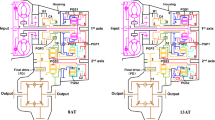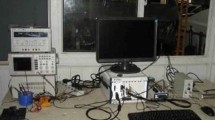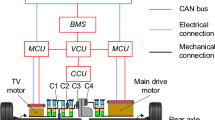Abstract
Road excitation is the basic input of vehicle vibration, which greatly impacts on vehicle ride comfort. In addition, it can cause vertical vibration of the vehicle, leading to deformation of the powertrain mount. Similarly, the longitudinal movement of the powertrain can also cause deformation of the powertrain mount. Due to the effect of the powertrain mount, there is a mutual coupling between the vehicle in the longitudinal and vertical directions, which has a great influence on the smoothness and comfort of the vehicle. In order to reveal the impact of random road excitation on the vehicle dynamic characteristics of a dual clutch transmission (DCT) vehicle under starting and shifting conditions, a longitudinal-vertical coupled dynamic model of the DCT vehicle considering the powertrain mount was established. This model includes dynamic torque model of the engine, powertrain mount model, transmission system model, tire model and road excitation model. The influence of random road excitation on the vehicle’s dynamic characteristics is analyzed under starting, shifting, and different starting and shifting intentions. The simulation results of the longitudinal-vertical coupling dynamic DCT vehicle model considering road excitation are compared with vehicle test results, the model is found to accurately reflect the influence of road excitation on the dynamic performance of DCT vehicles under starting and shifting conditions, thus verifying the correctness of the model.
Similar content being viewed by others
Abbreviations
- A n :
-
The amplitude of the trigonometric function corresponding to the harmonic degree
- c R :
-
The damping coefficient of each radial spring of the tire
- E T :
-
The kinetic energy of the system
- E D :
-
The dissipated energy of the system
- E V :
-
The potential energy of the system
- f :
-
The time frequency of the system
- F i (i = x, y, z):
-
The force transmitted by each mount in the x/y/z directions
- F mou :
-
The total force transmitted by the mount
- G q (n) :
-
The pavement roughness
- G q(n 0):
-
The pavement roughness coefficient
- k R :
-
The stiffness of each radial spring of the tire
- I e :
-
The moment of inertia of the engine crankshaft
- I f1/I f2 :
-
The moment of inertia of the primary and secondary ends of a dual mass flywheel
- I d :
-
The equivalent moment of inertia of the driving plate of the clutch
- I g1/I g2 :
-
The moment of inertia of the first and second gear driving gears
- I fd1 :
-
The moment of inertia of intermediate shaft 1 and final reduction drive 1
- I fd2 :
-
The moment of inertia of intermediate shaft 2 and final reduction drive 2
- I fd3 :
-
The moment of inertia of the driving gear of the final reduction drive
- I diff :
-
The moment of inertia of differential
- I h :
-
The moment of inertia of external input shaft
- I v :
-
The equivalent moment of inertia of the vehicle to the output shaft
- m p :
-
The mass of the powertrain
- m 2 :
-
The mass of reciprocating parts and a single cylinder piston
- m v :
-
The mass of the vehicle without powertrain
- n :
-
The spatial frequency
- n 0 :
-
The reference spatial frequency
- n 1 :
-
The harmonic number
- q j :
-
The corresponding road surface elevation
- R :
-
The wheel radius
- T e :
-
The torque of the engine
- T reci :
-
The reciprocating inertia of the piston motion
- T em :
-
The engine torque considering the engine intake
- z w :
-
The vertical coordinate of the wheel center
- v zw :
-
The vertical speed of the wheel center
- θ xp :
-
The torsional displacement of the mount along the forward direction of the vehicle
- θ yp :
-
The torsional displacement of the mount along the lateral direction of the vehicle
- θ zp :
-
The torsional displacement of the mount along the vertical direction of the vehicle
- Φ n :
-
The corresponding phase
- α j :
-
The angle between the element and the positive x-axis
- δ j :
-
Tepresents the deformation of the jth radial element
- λ :
-
The ratio of the connecting rod length and radius of the crank
References
T. E. Putra, Husaini and M. N. Machmud, Predicting the fatigue life of an automotive coil spring considering road surface roughness, Engineering Failure Analysis, 116 (2020) 104722.
C. H. Chin, S. Abdullah, S. S. K. Singh, A. K. Ariffin and D. Schramm, Durability assessment of suspension coil spring considering the multifractality of road excitations, Measurement, 158 (2020) 1076973.
I. Blekhman and E. Kremer, Vibrational resistance to vehicle motion due to road unevenness, Journal of Sound and Vibration, 405 (2017) 306–313.
I. Blekhman and E. Kremer, Vertical-longitudinal dynamics of vehicle on road with unevenness, Procedia Engineering, 199 (2017) 3278–3283.
Z. Guo, W. Wu and S. Yuan, Longitudinal-vertical dynamics of wheeled vehicle under off-road conditions, Vehicle System Dynamics, 60(2) (2022) 470–490.
M. L. Pollack, K. Govindswamy and T. I. Wellmann, NVH refinement of diesel powered sedans with special emphasis on diesel clatter noise and powertrain harshness, SAE Technical Paper (2007) 2007-01-2378.
T. Wang, S. Rakheja and W. B. Shangguan, Design of a hybrid proportional electromagnetic dynamic vibration absorber for control of idling engine vibration, Proceedings of the Institution of Mechanical Engineers, Part D: Journal of Automobile Engineering, 234(1) (2020) 56–70.
F. Lai, C. Huang and X. Ye, Analysis of vehicle driving stability based on longitudinal-lateral and vertical unified dynamics model, International Journal of Automotive Technology, 23(1) (2022) 73–87.
H. Wei, J. W. Lu and S. Y. Ye, Bifurcation analysis of vehicle shimmy system exposed to road roughness excitation, Journal of Vibration and Control, 28(9–10) (2022) 1045–1056.
Y. Yin, B. Luo, H. Ren, Q. Fang and C. Zhang, Robust control design for active suspension system with uncertain dynamics and actuator time delay, Journal of Mechanical Science and Technology, 36(12) (2022) 6319–6327.
X. Li, F. Li and D. Shang, Dynamic characteristics analysis of isd suspension system under different working conditions, Mathematics, 9 (2021) 1345.
W. V. Wedig, Turbulent travel speeds in nonlinear vehicle dynamics, Nonlinear Dynamics, 100(1) (2020) 147–158.
H. Wei et al., Hopf bifurcation and energy transfer of automobile shimmy system with consideration of road roughness excitation, Vehicle System Dynamics, 60(2) (2022) 454–469.
H. Zhang, Y. Zhang, X. Yu and X. Liu, Improved LQG vibration control for multiple inputs of electric vehicle, Advances in Mechanical Engineering, 14(1) (2022) 1–11.
C. Wang, J. Zhang, H. Zhou and H. Lu, Analysis of the running quality and road friendliness of the virtual track train in multiple running stages between stations, Journal of Mechanical Science and Technology, 36(2) (2022) 593–605.
H. Huang, H. Zheng, J. Deng, W. Li and Y. Li, Random analysis of coupled vehicle-bridge systems with local nonlinearities based on explicit time-domain method, Nonlinear Dynamics, 108(1) (2022) 81–95.
Y. Ma, J. Zhao and H. Zhao, MPC-based slip ratio control for electric vehicle considering road roughness, IEEE Access, 7 (2019) 52405–52413.
H. Wei, J. Lu, L. Shi, H. Lu and S. Ye, Modal analysis and dynamic shimmy behavior of vehicle-road system, Journal of Vibration and Control, 29(1–2) (2023) 387–399.
T. Wen-Peng, D. Jian-Ming and X. Xin-Xin, Modelling and characteristics of hybrid coupling hydro-pneumatic suspension for a seven-axle vehicle, Proceedings of the Institution of Mechanical Engineers, Part D: Journal of Automobile Engineering, 235(7) (2021) 1892–1901.
Z. Yu, Automobile Theory, China Machine Press (2009).
Z. Guo, D. Qin, A. Li, J. Feng and Y. Liu, Analysis of the influence of a powertrain mounting system on a dual-clutch transmission vehicle under typical working conditions, Applied Sciences, 12(15) (2022) 7439–7456.
W. S. Amer, T. S. Amer, R. Starosta and M. A. Bek, Resonance in the cart-pendulum system—an asymptotic approach, Appl. Sci., 11 (2021) 11567.
M. K. Abohamer, J. Awrejcewicz and T. S. Amer, Modeling and analysis of a piezoelectric transducer embedded in a nonlinear damped dynamical system, Nonlinear Dynamics, 111(9) (2023) 8217–8234.
M. K. Abohamer, J. Awrejcewicz and T. S. Amer, Modeling of the vibration and stability of a dynamical system coupled with an energy harvesting device, Alexandria Engineering Journal, 63 (2023) 377–397.
T. S. Amer, M. A. Bek and M. S. Nael, Stability of the dynamical motion of a damped 3dof auto-parametric pendulum system, Journal of Vibration Engineering and Technologies, 10(5) (2022) 1883–1903.
C. H. He et al., Controlling the kinematics of a spring-pendulum system using an energy harvesting device, Journal of Low Frequency Noise Vibration and Active Control, 41(3) (2022) 1234–1257.
T. S. Amer, I. M. Abady and A. M. Farag, On the solutions and stability for an auto-parametric dynamical system, Archive of Applied Mechanics, 92 (2022) 3249–3266.
T. S. Amer, F. M. El-Sabaa and S. K. Zakria, The stability of 3-DOF triple-rigid-body pendulum system near resonances, Nonlinear Dynamics, 110 (2022) 1339–1371.
S. Chowdhury and R. K. Yedavalli, Dynamics of low speed geared shaft systems mounted on rigid bearings, Mechanism and Machine Theory, 112 (2017) 123–144.
S. Chowdhury and R. K. Yedavalli, Dynamics of belt-pulley-shaft systems, Mechanism and Machine Theory, 98 (2016) 199–215.
S. Chowdhury and R. K. Yedavalli, Vibration of high speed helical geared shaft systems mounted on rigid bearings, International Journal of Mechanical Sciences, 142–143 (2018) 176–190.
A. R. Crowther, R. Singh, N. Zhang and C. Chapman, Impulsive response of an automatic transmission system with multiple clearances: formulation, simulation and experiment, Journal of Sound and Vibration, 306(3–5) (2007) 444–466.
T. Fu, S. Rakheja and W. B. Shangguan, Design of a hybrid proportional electromagnetic dynamic vibration absorber for control of idling engine vibration, Proceedings of the Institution of Mechanical Engineers, Part D: Journal of Automobile Engineering, 234(1) (2019) 56–70.
M. Jiang, S. Liao, Y. Guo and J. Wu, The improvement on vibration isolation performance of hydraulic excavators based on the optimization of powertrain mounting system, Advances in Mechanical Engineering, 11(5) (2019) 62–71.
R. Guo and T. Zhang, Vehicle Powertrain Mounting System, Shanghai Tongji University Press (2013).
GB7031-86, Vehicle Vibration-Describing Method for Road Surface Irregularity, National Standard of the People’s Republic of China (1986).
Acknowledgments
This work is supported by Research Program supported by National Natural Science Foundation of China (Grant No. U1764259), National Key R&D Program of China (2019YFE0121300), China.
Author information
Authors and Affiliations
Corresponding author
Additional information
Zheng Guo is currently pursuing the Ph.D. degree in vehicle engineering with Chongqing University. His main research interests are in the field of dynamic modeling and control of vehicle driveline systems.
Datong Qin was born in Chongqing, China, in 1956. He received the B.S., M.S., and Ph.D. degrees in mechanical engineering from Chongqing University, in 1982, 1984, and 1993, respectively. Now he is a Professor at the College of Mechanical and Vehicle Engineering, Chongqing University. He is former director of the State Key Laboratory of Mechanical Transmission, member of the Executive Committee of the IFToMM, and chairman of the Transmission Branch of the Chinese Mechanical Engineering Society. His research interests mainly include mechanical transmission and power transmission of vehicle.
Antai Li is currently pursuing the Ph.D. degree at Chongqing University, Chongqing, China. His research interests include vehicle power transmission system and electric control.
Jihao Feng is currently pursuing the Ph.D. degree in vehicle engineering with Chongqing University, Chongqing, China. His current research interests include the vehicle power transmission systems and big data.
Yonggang Liu (Senior Member, IEEE) received the B.S and Ph.D. in automotive engineering from Chongqing University, Chongqing, China, in 2004 and 2010, respectively. He was a joint Ph.D. student and a research scholar at University of Michigan-Dearborn, MI, USA, from 2007 to 2009. Now he is a Professor at College of Mechanical and Vehicle Engineering, Chongqing University. He is also a committee member of vehicle control and intelligence society of Chinese Association of Automation (CAA). His research interests mainly include optimization and control of intelligent electric and hybrid vehicles and integrated control of vehicle automatic transmission system.
Rights and permissions
About this article
Cite this article
Guo, Z., Qin, D., Li, A. et al. Influence of random road excitation on DCT vehicle dynamic characteristics during starting and shifting. J Mech Sci Technol 37, 4567–4582 (2023). https://doi.org/10.1007/s12206-023-0813-y
Received:
Revised:
Accepted:
Published:
Issue Date:
DOI: https://doi.org/10.1007/s12206-023-0813-y




